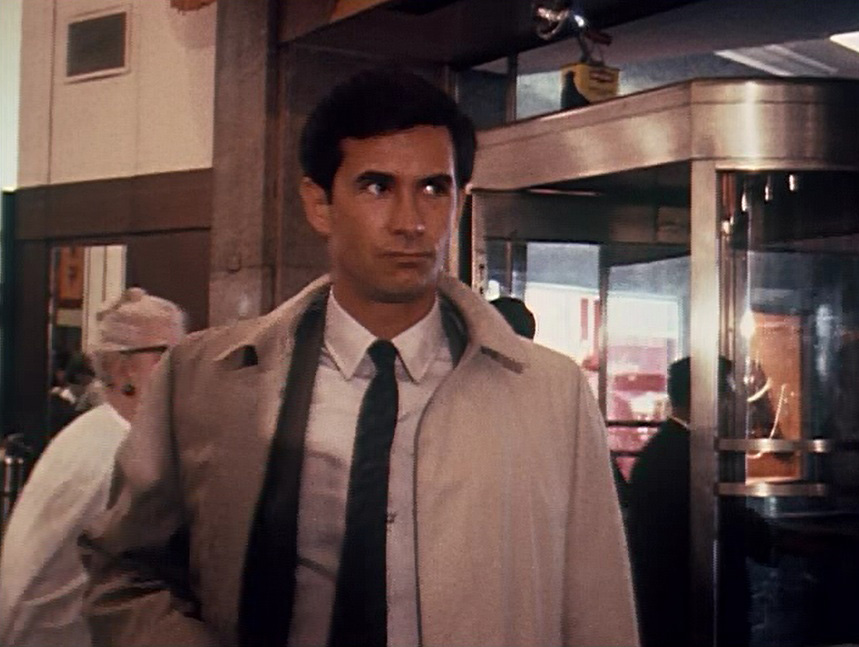Evening Primrose (lost color footage of ABC Stage 67 TV musical; 1966): Difference between revisions
Tudor Rose (talk | contribs) mNo edit summary |
Tudor Rose (talk | contribs) mNo edit summary |
||
| Line 10: | Line 10: | ||
It was directed by Paul Bogart, set design by John Ward, set decorated by Budd Gourmen, costume design by William McHone, and lighting design by Walter Urban. The cast starred Anthony Perkins as Charles Snell, Charmian Carr as Ella Harkins, Larry Gates as Roscoe Potts, Dorothy Stickney as Mrs. Monday, and Margaret Bannerman, Margaret Barker, Leonard Elliot, Mike Meola, Dorothy Sands, and Margaretta Warwick as store people. | It was directed by Paul Bogart, set design by John Ward, set decorated by Budd Gourmen, costume design by William McHone, and lighting design by Walter Urban. The cast starred Anthony Perkins as Charles Snell, Charmian Carr as Ella Harkins, Larry Gates as Roscoe Potts, Dorothy Stickney as Mrs. Monday, and Margaret Bannerman, Margaret Barker, Leonard Elliot, Mike Meola, Dorothy Sands, and Margaretta Warwick as store people. | ||
''Evening Primrose'' has easily become the most sought after part of the anthology series which aired it, ''ABC Stage 67'', mainly due to Sondheim's involvement. | ''Evening Primrose'' has easily become the most well-known and sought after part of the anthology series which aired it, ''ABC Stage 67'', mainly due to Sondheim's involvement. | ||
Though ''Evening Primrose'' was broadcast in color when it premiered on November 16, 1966, the original master tape has never been found.<ref> [https://sites.google.com/site/cultoddities/home/tv/evening-primrose Evening Primrose - Cult Oddities] Retrieved 20 Dec '17</ref> Black-and-white (B&W) kinescope versions are available for viewing at the Museum of Television & Radio branches in New York City and Beverly Hills. A newly discovered pristine B&W 16-millimeter copy was used for DVDs which were released commercially for the first time on October 26, 2010. | Though ''Evening Primrose'' was broadcast in color when it premiered on November 16, 1966, the original master tape has never been found.<ref> [https://sites.google.com/site/cultoddities/home/tv/evening-primrose Evening Primrose - Cult Oddities] Retrieved 20 Dec '17</ref> Black-and-white (B&W) kinescope versions are available for viewing at the Museum of Television & Radio branches in New York City and Beverly Hills. A newly discovered pristine B&W 16-millimeter copy was used for DVDs which were released commercially for the first time on October 26, 2010. | ||
Revision as of 08:20, 20 December 2017
A screenshot of the only known surviving color footage related to Evening Primrose, which consists of unused establishing shots showing Anthony Perkins on location.
Status: Lost
Evening Primrose is a 1966 TV musical with a book by James Goldman and lyrics and music by Stephen Sondheim. It is based on a John Collier short story published in the 1951 collection Fancies and Goodnights.
It was directed by Paul Bogart, set design by John Ward, set decorated by Budd Gourmen, costume design by William McHone, and lighting design by Walter Urban. The cast starred Anthony Perkins as Charles Snell, Charmian Carr as Ella Harkins, Larry Gates as Roscoe Potts, Dorothy Stickney as Mrs. Monday, and Margaret Bannerman, Margaret Barker, Leonard Elliot, Mike Meola, Dorothy Sands, and Margaretta Warwick as store people.
Evening Primrose has easily become the most well-known and sought after part of the anthology series which aired it, ABC Stage 67, mainly due to Sondheim's involvement.
Though Evening Primrose was broadcast in color when it premiered on November 16, 1966, the original master tape has never been found.[1] Black-and-white (B&W) kinescope versions are available for viewing at the Museum of Television & Radio branches in New York City and Beverly Hills. A newly discovered pristine B&W 16-millimeter copy was used for DVDs which were released commercially for the first time on October 26, 2010.
It's unclear if a color version of Evening Primrose still exists. At the time it was made, color videotape was expensive and so it was often reused. There has also been speculation that the master copy was stolen years ago by a knowledgeable but unscrupulous Sondheim fan.[2] This is due partially to the fact that color versions of many other ABC Stage 67 programs do exist, as well as certain anecdotal evidence compiled by Jane Klain, Research Manager at the Paley Center For Media.
References
- ↑ Evening Primrose - Cult Oddities Retrieved 20 Dec '17
- ↑ Five Things I Learned While Working on the “Evening Primrose” DVD Retrieved 20 Dec '17
